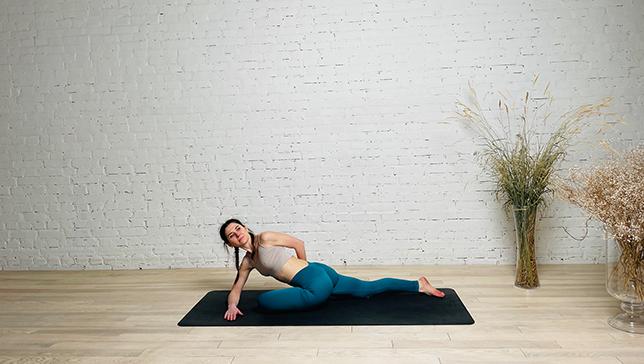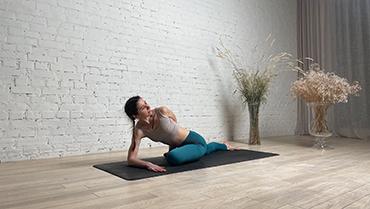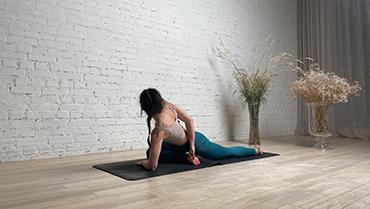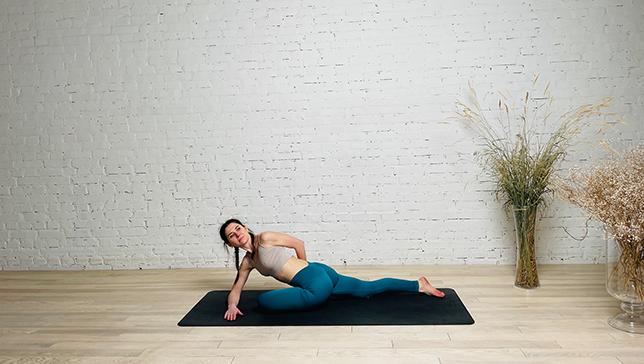Revolved Pigeon Pose - Parivrtta Kapotasana

Contents
Revolved Pigeon Pose or Parivrtta Kapotasana (par-iv-rit-tah cop-oh-TAH-sah-nah) is an intermediate hip-opener with a twist, creating an even deeper stretch of the hips and pelvis than the standard version of kapotasana. From Sanskrit, parivrtta means “revolved” or “twisted”; kapota means “pigeon”; and asana means “posture” or “pose.”
From kapotasana, the forearm that is opposite of the forward leg is placed on the mat in front of the shin. The body then twists away from the grounded arm, and the upper arm reaches around the back, resting on the waist or hip or grasping the big toe of the forward leg.
In addition to its physical benefits, parivrtta kapotasana is believed to activate and balance several of the chakras. As a twisting pose, it opens the manipura (navel center) chakra, which is associated with transforming power, self-esteem, motivation and confidence. The manipura also helps control anger and gives a sense of purpose.
Pose Detail
- Body Position: Backbend Yoga Poses, Seated Yoga Poses
- By Type: Balancing Yoga Poses, Chest Opening Yoga Poses, Flexibility Yoga Poses, Hip Opening Yoga Poses, Strengthening Yoga Poses
- Difficulty: Intermediate
- By Benefit: Yoga Poses For Digestion
Step-by-Step Instructions
Benefits and Contraindications
Improves overall flexibility and balance
Stimulates the digestive organs
Stretches the hips, thighs, and groin
Releases tension in the lower back and spine
Hip injury
Chronic or acute back pain
High or low blood pressure
Knee or ankle injury
Photo poses in different angles



Modifications and Props for Beginners
- Block or bolster support: Place a block or bolster under your hip or thigh to lift the hips and make it easier to rotate the torso. This can be especially helpful for those with tight hips or lower back pain.
- Knee support: If your knee is uncomfortable in this pose, place a blanket or pillow under it for support.
- Chair variation: Place a chair next to your mat and place your front foot on the seat of the chair. This can help alleviate pressure on the knee and make the pose more accessible.
- Strap assistance: Hold a strap between your hands and wrap it around your back to help you reach your foot or thigh. This can help those who have difficulty reaching or twisting in the pose.
Useful Tips
- Keep your hips level and squared to the front of the mat.
- Press down through your hands and feet to create length in your spine.
- Use your breath to deepen the twist, inhaling to lengthen and exhaling to twist.
Frequently Asked Questions
Revolved Pigeon Pose can be a challenging pose, especially for those with tight hips or lower back pain. It may not be suitable for everyone, and modifications or variations may be necessary to make the pose more accessible or avoid injury. It’s always best to consult with a qualified yoga teacher or healthcare provider before attempting any new pose.
Common mistakes to avoid in Revolved Pigeon Pose include rounding the spine, collapsing into the shoulders, or putting too much pressure on the knee. It’s important to maintain proper alignment, engage the core, and use props or modifications as necessary to avoid discomfort or injury.
The length of time you hold Revolved Pigeon Pose may vary depending on your level of experience and comfort in the pose. It’s generally recommended to hold the pose for 5-10 breaths on each side, or for a duration of 30-60 seconds.
Revolved Pigeon Pose may not be suitable for pregnant women, especially in the later stages of pregnancy. It’s always best to consult with a qualified yoga teacher or healthcare provider before attempting any new pose during pregnancy. Modifications or alternative poses may be recommended to ensure the safety of both the mother and baby.
Variations
- Half Pigeon Pose
- Sleeping Swan Pose
- Revolved Pigeon Pose With A Chair
- Flying Pigeon Pose